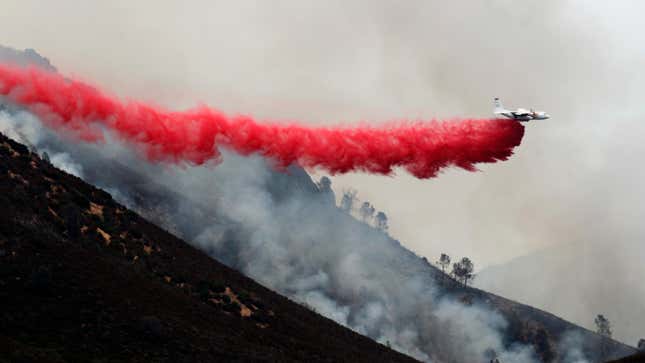
A federal judge is hearing arguments today in a Montana lawsuit that seeks to curb the U.S. Forest Service’s use of aerial fire retardant over concerns that the chemical mix is polluting waterways.
The lawsuit was filed in October 2022 through the U.S. District Court in Montana by Forest Service Employees for Environmental Ethics. In the filing, the environmental group argued that the Forest Service’s “discharge of aerial fire retardant into navigable waters of the United States” is a violation of the Clean Water Act. The environmental nonprofit requested a court order that could stop the Forest Service from using fire retardant chemicals.
If you’ve seen photos of low-flying aircraft dropping clouds of red powder over a fire, that’s the fire retardant. It “reduces wildfire intensity and rate of spread, decreasing risks to firefighters, enabling them to construct fireline safely,” according to the Forest Service.
But plaintiffs in the lawsuit argued that the mix of substances can be harmful to the environment. Retardant is made up of water, salts, and fertilizers, according to the U.S. Department of Agriculture. A report from the USDA analyzed 148 aquatic species and found that 32 marine animals are “likely to be adversely affected by the use of aerially delivered retardant.” This is concerning because the Forest Service has used more than 102 million gallons (386 million liters) of aerial fire retardant between 2012 and 2019, according to the USDA.
After the lawsuit was filed, the Forest Service asked the Environmental Protection Agency to develop a permit that would allow it to continue using fire retardant chemicals, the Los Angeles Times reported. But according to the EPA, creating that permit would take more than two years. Worried about that gap in the face of recent disastrous fire seasons, several groups have tried to intervene in the lawsuit. A coalition made up of California communities, including Paradise, California, which was hit by a disastrous 2018 wildfire that killed 86 people, argued on behalf of the Forest Service. They said that limiting the use of fire retardants could put lives at risk, the Associated Press reported. The federal judge denied the coalition’s request.
The country’s wildfire season is being made worse by climate change; hotter and drier conditions have created more destructive wildfires. Officials have argued that not being able to use the fire retardant could hurt their ability to stop quick-moving fires from getting out of control. “It buys you time,” Scott Upton, a former firefighter for California’s state fire agency, told the Associated Press. “We live in a populous state—there are people everywhere. It’s a high priority for us to be able to use the retardant, catch fires when they’re small.”
But the Forest Service Employees for Environmental Ethics are adamant that it’s not worth the risk to the environment. “There’s no scientific evidence that it makes any difference in wildfire outcomes,” Andy Stahl, the organization’s executive director, told the Los Angeles Times. “This is like dumping cash out of airplanes, except that it’s toxic and you can’t buy anything with it because it doesn’t work.”
The arguments that a federal judge will hear this week are part of a string of lawsuits from the Forest Service Employees for Environmental Ethics against the U.S. Forest Service. The organization first sued the Service in 2003, the LA Times reported.
Want more climate and environment stories? Check out Earther’s guides to decarbonizing your home, divesting from fossil fuels, packing a disaster go bag, and overcoming climate dread. And don’t miss our coverage of the latest IPCC climate report, the future of carbon dioxide removal, and the un-greenwashed facts on bioplastics and plastic recycling.

